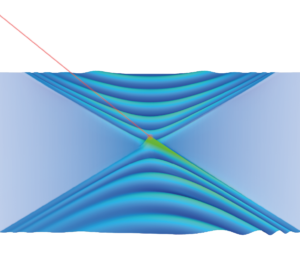
The lattice symmetry of a crystal is one of the most important factors in determining its physical properties. Particularly, low-symmetry crystals offer powerful opportunities to control light propagation, polarization and phase. Materials featuring extreme optical anisotropy can support a hyperbolic response, enabling coupled light–matter interactions, also known as polaritons, with highly directional propagation and compression of light to deeply sub-wavelength scales. Here we show that monoclinic crystals can support hyperbolic shear polaritons, a new polariton class arising in the mid-infrared to far-infrared due to shear phenomena in the dielectric response. This feature emerges in materials in which the dielectric tensor cannot be diagonalized, that is, in low-symmetry monoclinic and triclinic crystals in which several oscillators with non-orthogonal relative orientations contribute to the optical response. Hyperbolic shear polaritons complement previous observations of hyperbolic phonon polaritons in orthorhombic and hexagonal crystal systems, unveiling new features, such as the continuous evolution of their propagation direction with frequency, tilted wavefronts and asymmetric responses. The interplay between diagonal loss and off-diagonal shear phenomena in the dielectric response of these materials has implications for new forms of non-Hermitian and topological photonic states. We anticipate that our results will motivate new directions for polariton physics in low-symmetry materials, which include geological minerals, many common oxides and organic crystals, greatly expanding the material base and extending design opportunities for compact photonic devices.